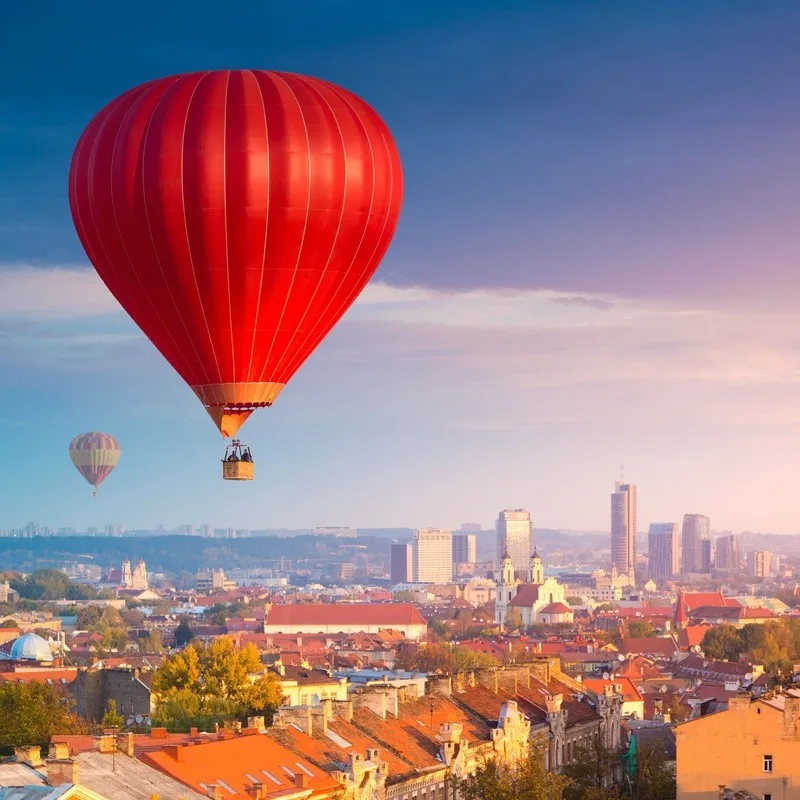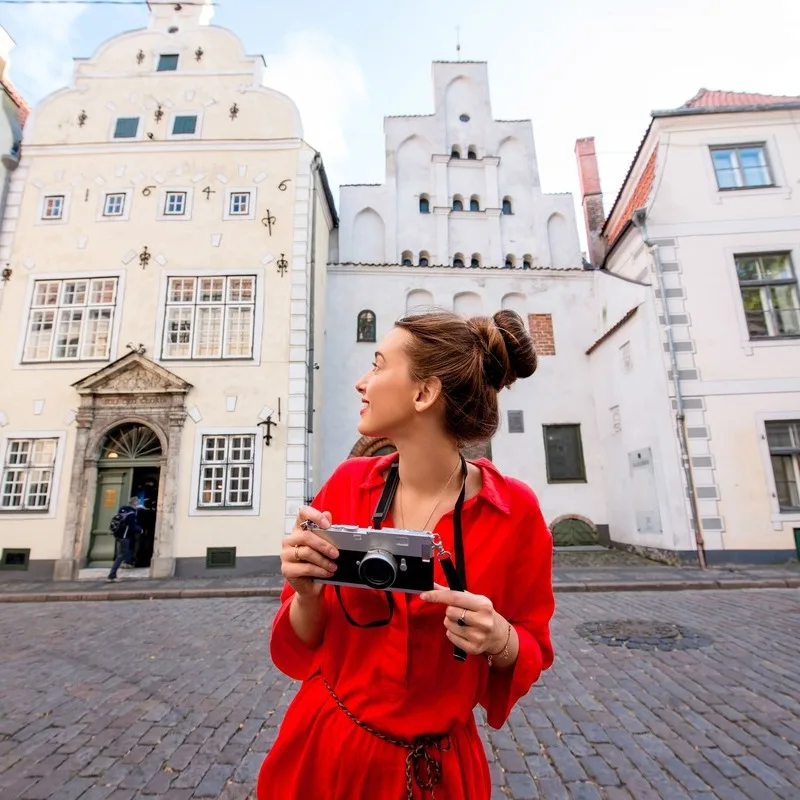Europe is bracing for a record surge in tourism this summer, as 2023 marks the first year borders are fully open and all restrictions have been lifted across all countries.
Interestingly, it's the lesser-known spots that are stealing the spotlight this year, from unheard-of countries in Mediterranean South, like Albania, to post-Soviet states in the East that had recorded very few tourists prior to the continent's wider reopening, such as Moldova.

Accompanying the trend, one of Europe's hugely underrated regions is, at last, surging in popularity among vacationers, as it offers not only a wide array of attractions but more affordability and less crowds.
This summer, tourists are flocking to the three Baltic countries, and this is why:
Meet The Beautiful Baltic States
The Baltics are the informal title given to three sovereign states lining the Baltic Sea in Northeastern Europe. From West to Northeast, they are Lithuania, Latvia, and Estonia.
You might have come across these names recently, particularly if you're a part of the digital nomad community, as they have risen to prominence as trendy countries for remote workers, but in case these do not ring a bell, allow us to introduce you properly:

The Baltics share a long and complex common History, having existed either as separate, self-governing entities or as part of much larger empires or unions, such as Tsarist Russia or the Soviet Union (USSR).
In fact, up until the early nineties, all three were within reach of Moscow's sphere of influence, and as former USSR-aligned states, they have collectively suffered from being under communist rule, mostly throughout the 20th century, an experience that's certainly shaped their nationhood and cultural identity.
Top 5 Travel Insurance Plans For 2023 Starting At $10 Per Week
Easily Earn Points For Free Travel

As reported by the Baltic Times, the leading publication in the region, these three countries are ‘becoming more popular' as tourists from America, and other parts of the world, seek alternatives to an over-crowded, over-priced Southern Europe.
Last year alone, when travel restrictions still plagued parts of Europe, Latvia already registered a whopping 65.2% uptick in tourist overnights in local accommodations.
More recently, Estonia also reported a 31% year-on-year increase, and Lithuania did not trail behind, with tourist arrivals on an upward curve following the COVID slump.

But why have the Baltics become so popular, and are they really worth a visit?
Let's start with Lithuania.
Lithuania
Medieval castles and a vibrant capital
Lithuania is the Westernmost of the Baltic states and perhaps the most culturally charged of them, with a History dating back at least to the 14th century, when the now-dissolved Grand Duchy of Lithuania was the largest country in Europe.
Its capital, Vilnius, is famous for the red tile roofed-Old Town, so large and well-preserved it was declared a UNESCO World Heritage Site as early as 1994, and beautiful Baroque architecture with a distinct ‘Vilnian' flair.

It is the largest city in Lithuania, a country of iconic medieval castles – think Trakai, an island castle a short half-hour drive Southwest of Vilnius – unspoiled nature reserves, and a small, albeit gorgeous coastline dotted with traditional fishermen villages and with 98 km of swim-friendly beaches.
The official language is Lithuanian, which is closely related to Latvian, but not Estonian, and the country's official currency is the Euro.
On to Latvia.
Latvia
Up-and-coming resort scene and fascinating culture
Lithuania's direct neighbor to the Northeast, bypassing the Russian exclave of Kaliningrad, Latvia is perhaps the lesser-known Baltic country.
Unlike Lithuania, it did not achieve independence through the bulk of its long history, having been controlled by Teutonic (or German), Swedish, Polish, Lithuanian, or Russian powers from the Middle Ages through the 19th century.

It would finally attain statehood in 1918, when it seceded from the German Empire, though Latvian's ‘freedom' would not come to fruition until the nineties, when the Soviet Union, which it was incorporated into, dissolved.
Due to its strong links to Russia, it is still home to a large ethnic Russian minority, as much as a quarter of the population.
Nevertheless, Latvia has chosen its own path, having modernized itself as a fully-functioning democracy at an unprecedented pace in recent decades and enjoying a high level of human development.
The country's main attraction is surely its charming capital of Riga, home to over 600,000 people, or a third of the population, and similarly to Vilnius, the historic center has been inscribed into UNESCO's World Heritage list in recognition of its Art Nouveau heritage.

Outside Riga, Latvia has a contrasting laid-back feel, with up-and-coming coastal resort zones in towns like Jurmala, a popular sunny getaway with a long stretch of sandy beach bounded by the Baltic Sea, and a quaint countryside, best experienced in historic hotspots like Cēsis, where an imposing citadel still stands, and the cobblestone-laden, 17th-century gem of Ventspils.
The state language is Latvian, and the country's economy is ‘Euroized', like much of the European Union.
Estonia
Charming historic capital and beautiful countryside
The Northeasternmost of the Baltic states, Estonia lies a stone's throw away from the mainland Russian border, and from Finland, across the Baltic Sea, and arguably, it has the most beautiful capital out of the three.

Tallinn is a medieval gem – yet again, protected by UNESCO – that has miraculously not experienced any major reconstruction nor destruction since it was first settled by Baltic traders in the 13th century.
This is a truly surprising feat, seeing it would come under the control of and face invasion from much larger empires.
Featuring an ‘Upper Town', distributed along a limestone hill, and a ‘Lower Town', where much of the cobbled streets, medieval alleys, and church spires are centered, it makes for an impressive cityscape, easily recognized from above, and from the sea when Finland passenger ferries are approaching the Estonian coast.

Other beautiful spots in Estonia include Tartu, its second most important city, described as the oldest in the Baltics with a landmark university and a walk-able, postcard-ready Old Town, and the Laheema National Park, a favorite among nature seekers and hikers, with sweeping panoramas of the Estonian countryside and its rolling green hills.
Uralic-originated Estonian is the official state language, though a sizable minority speaks Russian due to being ethnic Russians – a legacy of the USSR period – and the country's currency has been the Euro since it ascended to the European Union.
Why Should You Visit The Baltics?

Now that you've familiarized yourself with each of the three Baltic states, you might be thinking: ‘sounds interesting, but how exactly do they stand out among other equally gorgeous, more popular European states, and why should I visit them instead of Poland, the Czech Republic, Hungary, and the like?'
Or even: ‘are they even safe, considering how close they are to Russia? And how about local prices? Are they cheap?'
It's yes, yes, and yes.
Going further into detail, the Baltics are one of Europe's most overlooked regions precisely due to misconceptions stemming from the USSR period.

On Safety
One must bear in mind this is 2023, and all three Baltic states severed ties to Russia a long while ago – in fact, most of the local populace never supported being in a communist regime in the first place.
Since 2004, all three have been members of the European Union, which firmly plant them in the democratic Western World, and on top of that, they are NATO members.
This means they are just as safe a territory as France, Germany, Italy, or Spain, seeing that Russia cannot be aggressive towards the Baltics without triggering an immediate response from NATO allies.

Additionally, Lithuania, Latvia, and Estonia are all considered Level 1 countries by U.S. authorities. That's certified ‘safe', as Americans are able to take ‘normal precautions' when visiting due to the low risk of warfare, negligible crime rates, and high perception of public security.
Believe it or not, they are among Eastern Europe's safest destinations.
Affordability
Other than their boundless natural beauty, scenic coast, and centuries-old stately capitals that are deemed inestimable heritage sites by UNESCO?

The Baltics are more affordable than their Western counterparts. Not quite the non-EU Balkans, but still fairly cheap.
They may have been a lot cheaper prior to the introduction of the Euro, and their induction into the European Union, but tourists still benefit from lower prices, while long-term residents report a not-so-burdensome cost of living in spite of the strong currency.
Here are some bullet points that may help prove this, with data gathered by the popular crowd-sourced database on perceived prices Numbeo:
- Consumer prices in Vilnius are up to 32.2% lower than in Paris
- Restaurants in Riga can be 14.7% cheaper than in Vienna
- Grocery prices in Tallinn are on average 23.6% lower than in Berlin
- An inexpensive restaurant meal in Vilnius costs roughly US$10.97
- A pint of local beer in Riga is US$4.39 on average
- Tourists should expect to pay a taxi fare of US$0.88 for each 1 km covered in Tallinn

In sum, the Baltics have a vast and diverse tourist offer, and it presents visitors, particularly those hailing from across the pond, both with the culture and the crowd-free European cities they dream of visiting.
The Ideal One-Week European Getaway
Plus, as these are really small countries, smaller even than some of the smallest U.S. states, you can easily explore much of the Baltic coast over a single week.
Regular bus service connects all three Baltic capitals, and if you're driving across the territory, you'll be able to see a lot more and in a much shorter time-span. Traveling from West to East, this is the driving distance between them:

- Vilnius – Riga (3h38 via A2 and A7)
- Riga – Tallinn (4h13 via A1 or the Tallinn-Pärnu-Ikla/Route 4)
A nonstop drive from Vilnius to Tallinn takes about 7 hours to complete, with no overnight stops in Latvia or other points in between.
Alternatively, you can fly between the three capitals with Air Baltic, the leading carrier in the region, reducing the duration of your journey to only 50 minutes, whether you're flying from Vilnius to Riga, Vilnius to Riga, Riga to Tallinn, or Tallinn to any of the other two capitals.
The Travel Off Path Advantage: Your Travel Toolkit
U.S. Travel Advisory Checker
An easy tool to check all the latest travel advisories from the U.S. State Department.
Entry Requirements Checker
An easy tool to check all the entry requirements for your destination.
The Upgrade Newsletter
Unlock travel tips, hot destination insights, and exclusive flight deals.
Join Our Community
With over 25,000 members on Facebook!
Subscribe To Our Latest Posts
Enter your email address to subscribe to Travel Off Path's latest breaking travel news, straight to your inbox.

Elena
Tuesday 11th of July 2023
You said that Lithuania has more history and the Estonian capital is the most beautiful, but most of the city pictures you used are from Riga, Latvia. Riga is the biggest city, it has the biggest old town, which is the main attraction in each of the three countries, and the Latvian coastline is the longest with wonderful sandy beaches. In addition, if you look at the map, Riga is located right in the middle and has the largest and the most convenient airport that even Lithuanians and Estonians use. And if anyone is concerned about Russia, the Latvian coastline and the capital Riga are further away from the border with Russia or their friend Belarus.